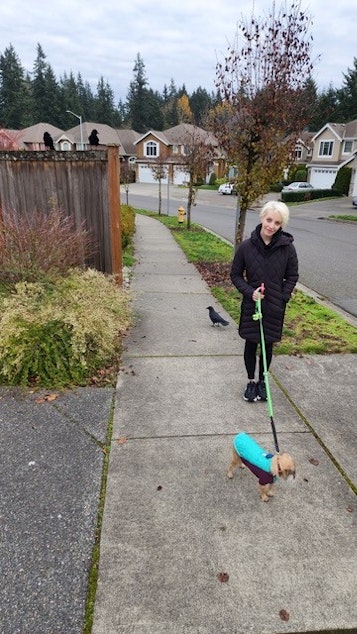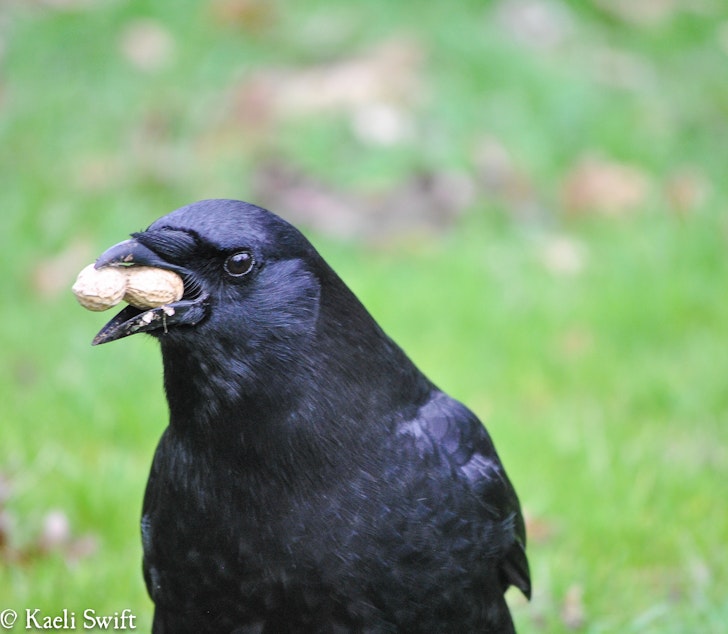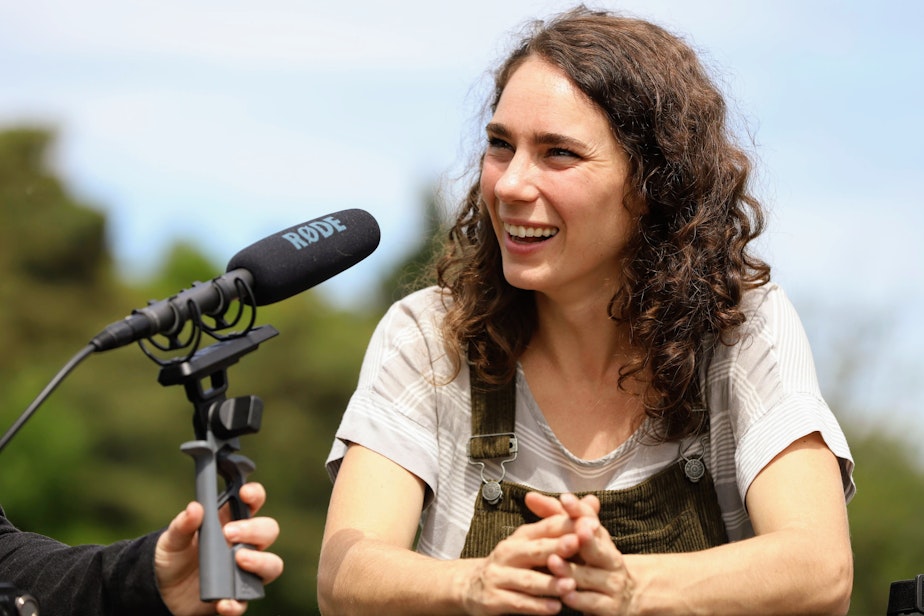Seattle crows, beloved and feared, may be playing us with their primate-sized brains

Seattle has a thing about crows.
Crows are ubiquitous to the city — a single roost at the University of Washington Bothell campus is home to as many as 16,000 birds. The sight of thousands of crows flying toward the campus at dusk has become one of Seattle’s signature attractions for those in the know.
A crow-filled sky might stir Hitchcockian visions for some, a “murder” of crows harassing people when they venture outside. This is the time of year when Seattleites take to social media with tales of protective crow parents dive-bombing them for unwittingly wandering too close to crow fledglings too young to fly.
The advice to those pleading for help is almost unanimous: Befriend the crows.
But researchers have observed another facet of the human-crow relationship: Crows, which have brains the size of a small primate's, may be playing us.
Sponsored
Kira Jane Buxton, 42, lives in the Bothell area and has developed relationships with several crows over the years. But her most endearing relationship was with a female crow she named T.
“I still joke to my husband that she was the love of my life,” Buxton said. “It was such an honor and a privilege to be that close to a wild bird, and to share space with her, and to see her sunbathing, just all these little quirky behaviors. And I miss her. I do.”
Wait, crows sunbathe?
“They splay their wings out and they lift their beautiful heads to the sky with their beaks open,” Buxton explained. “It’s very relatable. They’re just enjoying the sun.”
A symbiotic relationship
Sponsored
The unique connection between humans and crows was the focus of a study by two longtime University of Washington professors and corvid enthusiasts, John Marzluff, a wildlife biologist, and Marc Miller, a cultural anthropologist.

Marzluff and Miller went to the places where Seattle residents interact with crows and studied not only the behaviors of the crows, but also the behaviors of people who befriend crows, an approach Miller referred to as “anthrozoology.”
“Instead of studying creatures to see what's our influence on them, say their population, size, or their health, or their movements, it could be, well, what does an animal of some kind mean to a human, to a child reading a book?” Miller said.
The scientists divided their subjects into three overlapping categories in terms of their relationships with crows — crow friends, crow feeders, and crow observers.
Sponsored
“These people are really motivated by having a bond with a wild animal, and the crows reciprocate that strongly,” Marzluff said.
More than just food
While science suggests that crows do what they do to keep people feeding them, Buxton and others who have developed relationships with crows believe the bond is much deeper.

Buxton began spending more time in her yard to get to know T. and her more standoffish partner who Buxton named Dart. Because she was outside more, she started feeding and observing hummingbirds, as well as her crows. T. brought Buxton gifts, but not the shiny things crows are known for bringing to the people who befriend and feed them.
Sponsored
Instead, T. brought Buxton an apple from a neighbor’s yard. Another time, she delivered an empty carton of chicken nuggets and what Buxton described as “a lovely, imperfect acorn.”
“My favorite thing was they used to line up pieces of moss perfectly,” she said.
Then one day from inside her home, Buxton saw Dart, who generally kept his distance from her, fly down and put something in her yard.
“He kept looking up at the window at me and then would kind of look down at whatever he’d put there and kind of move it around,” she said. “Then he’d look up at me.”
When she finally went into the yard to investigate, she found the body of a dead hummingbird, perfectly intact.
Sponsored
“I’ll never know whether he found it and brought it to me, or whether he had, you know, captured it himself,” she said. “It was amazing to me. It was an offering.”
Recognizing and remembering humans
Whether crows are capable of feeling and expressing gratitude, there is no doubt that they recognize and remember people, both those who provide them with sustenance and people they consider dangerous.
Sixteen years ago, Marzluff and his team caught crows on the University of Washington campus while wearing “caveman” masks.

Their research was featured in a PBS Nature documentary called “The Murder of Crows.”
Every year since then, Marzluff or one of his students, walks around campus wearing the same mask. All these years later, UW crows still react violently to what they perceive as a threat.
“Most of the birds that recognize us have never encountered us directly,” Marzluff said. “Those birds are all dead now and some of this information seeps through the social group.”
Crows and grief
After Katie Brotten lost her dog in 2023, she continued going on long walks she used to take with him along a river loop. She started feeding dry cat food and peanuts to the crows she encountered along the way.
“They would recognize me. They recognized my car,” Brotten said. “They would fly over as soon as I pulled into the trail parking lot. And we've just sort of developed this relationship.”

Like Buxton, Brotten started finding “gifts” along a secluded section of the trail that she assumed were from her new crow friends — a wallet (which Brotten returned to the bank), a gold-plated bracelet, a woman’s shoe.
As Brotten got to know the crows, she found that their sounds changed, from the typical “Caw! Caw!” to a more gurgling sound, almost like a purring, that she took to mean they were happy.
She was so impacted by her growing connection with crows in the wake of her dog’s death, Brotten wrote and published a nonfiction book, “Worthy Caws: A year of healing and communing with crows.”
“Sometimes when we're with friends or family members, there's this expectation to talk or to be a certain way or whatever. But with my crows, it was just this really wonderful relationship where I would take my walk, I would see them, I would interact with them,” she said. “They were exhibiting a lot of communicative techniques and we started to understand each other.”

Buxton was similarly inspired by her relationship with T., who she believes died in 2021, after the crow gradually got sick from what may have been a neurological disease. One day, Buxton heard a commotion in the trees where T. and Dart nested. She never saw T. again. Dart came back a final time and sat for a long time on Buxton’s roof.
“He was alone,” she said. “I had never seen them apart.”
In the wake of T’s apparent death, Buxton wrote and published an apocalyptic novel from the perspective of a crow, based on T., called “Hollow Kingdom.”
“Hollow Kingdom” was described by author Karen Joy Fowler as “a foul-mouthed crow is humanity’s only chance to survive Seattle’s zombie problem.”
Quid pro crow
While human-crow relationships can be inspirational (at least for humans), they can also remain strategic and functional.
Stephanie Stonesifer, who lives in the SeaTac area, feeds crows to protect her chickens.

Last fall, while on a family vacation at Disneyland, Stonesifer watched in horror as one of the chickens she had raised from a chick was attacked and eaten by what appeared to be a hawk. The grisly scene was captured live by her backyard camera.
“Circle of life and all that, but it’s still a bummer,” she said. “So, I was trying to figure out, how can I protect my birds?”
Stonesifer decided that the best way to guard her chickens was to encourage the presence of crows, which she had seen harassing birds of prey above her wooded neighborhood. Her husband built a flat platform where she puts her crow offerings — peanuts and the occasional chicken egg.
She claims that, at least for the last six months, the increased presence of crows has reduced the number and frequency of raptors circling above her yard.
“It’s been working so far,” she said. “The attack happened in October of last year and I haven’t lost any chickens to hawks or eagles or anything else since then.”
Crow funerals
Another source of scientific interest in crows revolves around crow funerals. Kaeli Swift, a postdoctoral researcher in the UW’s College of the Environment, wrote her dissertation about the way crows react to death.

To do her research, Swift placed dead crows at different spots ranging from Kent to North Seattle and observed the response of other crows.
“When the first bird discovers the body, it will produce an alarm call and that alarm call will often result in the recruitment of other crows,” Swift explained. “This is a very noisy event. They'll fly around, occasionally landing in trees, and the whole thing kind of lasts about 15 or 20 minutes.”
Buxton's first meaningful encounter with crows, before she befriended T. and Dart, involved a dying crow. One day, she came upon a group of crows in her neighborhood who were cawing loudly above an injured crow on the road.
Buxton didn’t know what to do. She went and grabbed a box. As soon as she put the injured crow inside, the collected crows in the trees around her went silent.
“I had this feeling that the crows understood that I was there to help,” Buxton said. She took the crow to a wildlife facility, but the injured bird died.
From that moment, Buxton said her relationship with crows changed.

 1 min
In recent years, Kira Jane Buxton has developed a new relationship with a crow she named "Sharkey." Here, she goes on a walk with her dog, Ewok, with Sharkey tagging along.
1 min
In recent years, Kira Jane Buxton has developed a new relationship with a crow she named "Sharkey." Here, she goes on a walk with her dog, Ewok, with Sharkey tagging along.
“They started following me, and I was watching them, and there was never any sense of it being an aggressive thing,” she said. "They were observing me, and I was observing them.”
Demystifying crow behavior
Swift has a more scientific explanation for the crows falling silent. They might have just completed their crow funeral and were preparing to disperse. Or they might have seen the injured crow disappear and figured Buxton had eaten it or was planning to eat it.
“I would be very hesitant to say that crows understood her intentions,” she said.
Standing around Seattle neighborhoods waiting for crows to notice the dead crow she put on the ground, Swift has had a lot of interaction with Seattleites who question her and then rave about the crows and explain their unique connection with the birds.
But Swift, an ornithologist who studies animal behavior, quickly realized that for the crows, these human connections were far from exclusive.

“I would start to see the math,” Swift said. “This person feeds their crows at 8 a.m. And then they don't even know, but their neighbor, they put the food out at 9. And then the guy down the street, he does his walk with his dog and he feeds the crows the whole time. Every person in the neighborhood thinks that they're getting this unique thing.”
But that commonality, the shared experience of crow encounters that seems to span across Seattle, does not diminish the impact crows have on the people who forge those bonds. Crow friendships inspired both Buxton and Brotten to write books. Crows have inspired artwork across the city, including a 12-foot-tall crow eating a giant French fry in Auburn, and crow-focused murals on Capitol Hill.
The value of crow friendships
Befriending crows may not be as unique as some Seattleites imagine, but for many it is an important way to bridge the gap between themselves and nature within an urban environment.
From a scientific perspective, Swift points out that 40% of a Seattle crow’s diet is garbage, so feeding them peanuts or pet food is not going to impact their metabolism.
Both she and Marzluff encouraged people to moderate how much they feed crows — preferably a few treats as opposed to a giant bag or pounds of peanuts (especially since the birds are likely getting food throughout the day from other crow-obsessed Seattleites).

From an anthrozoologic perspective, crows help people find connections they may lack elsewhere in their lives without the complications of dealing with other humans.
“Sometimes it's more than important, it's essential,” Swift said. “It is one of the main sources of companionship for people who otherwise can't keep pets or don't get a lot of visitors. It's one of the main ways that they socialize and engage. These birds, they can play a really pivotal role in people's lives.”

